If the Ice is Good, the Sails Go Up
Zooming across frozen lakes at up to 70 miles per hour, ice boat sailors of Maine keep their sheets full year-round.
Wolfie Wessel fell through the ice once.
It was about four winters ago on Pushaw Lake, north of Bangor. When he pulled himself out beside his boat, he jumped up and down on what he’d thought was solid ice on the shallow lake. “There were holes like Swiss cheese everywhere.”
Wessel, who lives in Friendship, is recounting the story on a blue-sky February Saturday while standing on the ice of a different lake, near Nobleboro in Lincoln County. More than two dozen boats are lined up on a narrow portion of Damariscotta Lake. Each is equipped with three steel runners, one at the bow and two attached to a plank below the hull—their blades sharpened to a V-point to cut into the ice. Here and there, someone steps into the one-or two-seat crafts and starts sailing, with each boat making the chatter of an oversized ice skate on the mostly frozen lake.
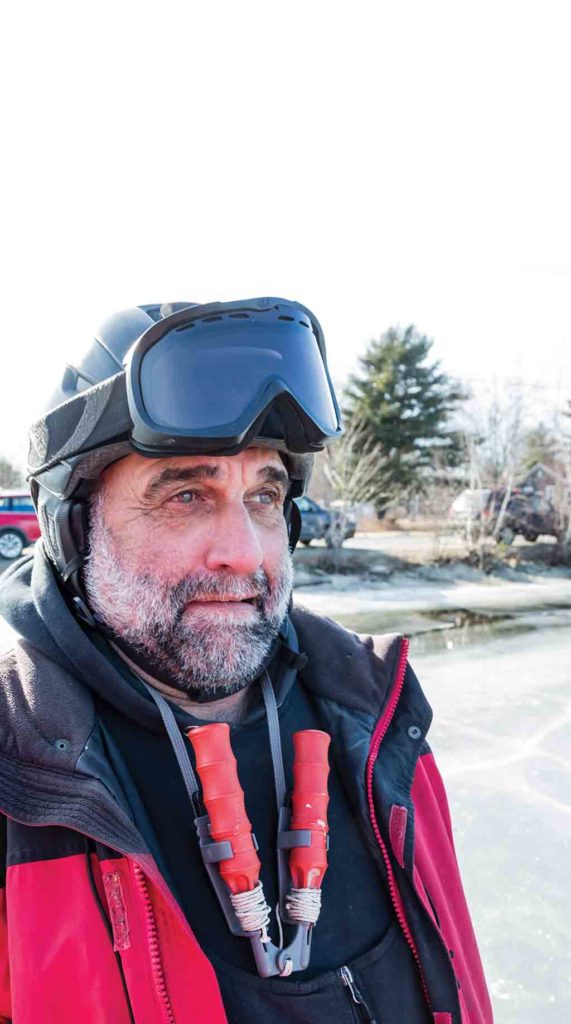
Longtime ice boater Wolfie Wessel always keeps a pair of ice safety picks on a strap around his neck, just in case he should need to pull himself back onto firm ice. 
The boat lineup on a February day on Damariscotta Lake.
The lake ice is solid where the boats are gathered, but the shoreline is melting. Beside the causeway where most of the cars are parked—with license plates mostly from Maine, Quebec, and Massachusetts—the span of open water has been opening up in the sunshine since photographer Peter Frank Edwards and I arrived. Someone has placed a couple of boards across the slush to help participants and onlookers avoid splashing or stepping in.
Wind, frozen water, and boats—it can be dicey, this icy winter sport. But Wessel is one of a hardy cadre of ice-boating devotees in Maine and New England and throughout the upper Northwest, Canada, and other places around the world. “You got a boat?” he asks a newcomer. “If you want to try, I’ve got the slowest boat in the fleet.”
The Dammy and the DN
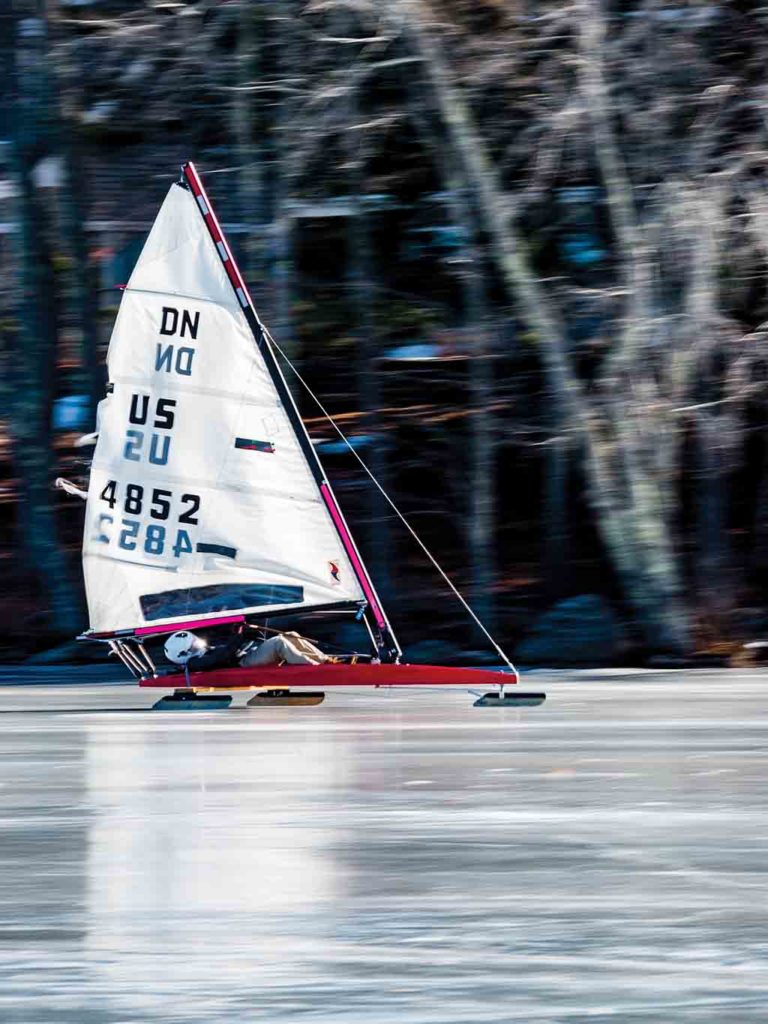
At nearly 14 miles long and depths up to 110 feet, Damariscotta Lake, or the “Dammy,” as we hear it called by several people we meet, is the largest body of fresh water in coastal Lincoln County. Yet on this tree-edged section in winter, it feels compact, with ice boats and people all around. Onlookers are a snow-boot-wearing crowd, a few with dogs on leashes, with a couple of ice-skaters who have skated from across the lake.
It’s a colorful spectacle on the white expanse, and the boats themselves are interesting to see, whether in motion or “parked.” Walking among them is akin to checking out a classic-car cruise-in, where owners are often nearby if you have questions. Each boat looks something like a go-kart crossed with a sailboat, and participants say the clear ice and 10 to 15 mph winds with exciting gusts are making it a good day for sailing. Each is rigged with a mast and at least one sail and seating for one or two persons. It’s my first time seeing the boats up close, and from the men and women we meet, I learn that nearly all of the vessels were built by hand in backyard shops or garages using designs—often modified and personalized—that are shared among the participants.
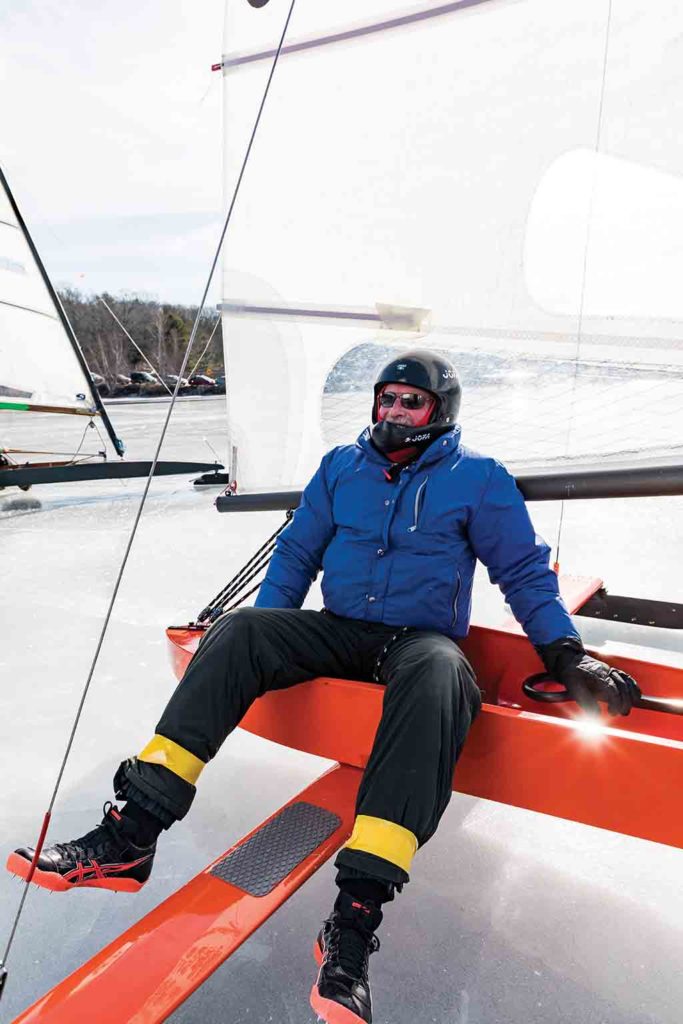
As I look at the aerodynamic lines and single sail of a deep orange boat, its owner, Dave Fortier, who is an officer of the midcoast-area Chickawaukie Ice Boat Club, explains that it’s a DN, the most common design seen in ice-boating races worldwide; others on the ice that day are Skeeters, Cheapskates, Gambits, Skimmers, Whizzes, and various homemade, one-of-a-kind models. The popular DN model originated in the 1930s, when the era’s ice boats were much larger and heavier—stern-steering yachts that provided a leisure pursuit among the wealthy of the Great Lakes and on New York’s Hudson River. The Detroit News in Michigan held a contest to find an inexpensive boat that could be built at home and transported on a car rooftop. The winning design was 12 feet long and about 100 pounds, dubbed “DN” after the newspaper’s name. Plans were published, and ever since, Fortier says, the low-cost design and others like it have allowed a much wider range of people to build their own boats and enjoy the sport.
Meanwhile in Searsmont and Camden
The building and repairing of boats happen mostly in other seasons, the boaters say. Some of the longtime members have a barn or workshop expressly for their wintertime boats and for the trailers they need to transport them to the various ponds and lakes where they sail.
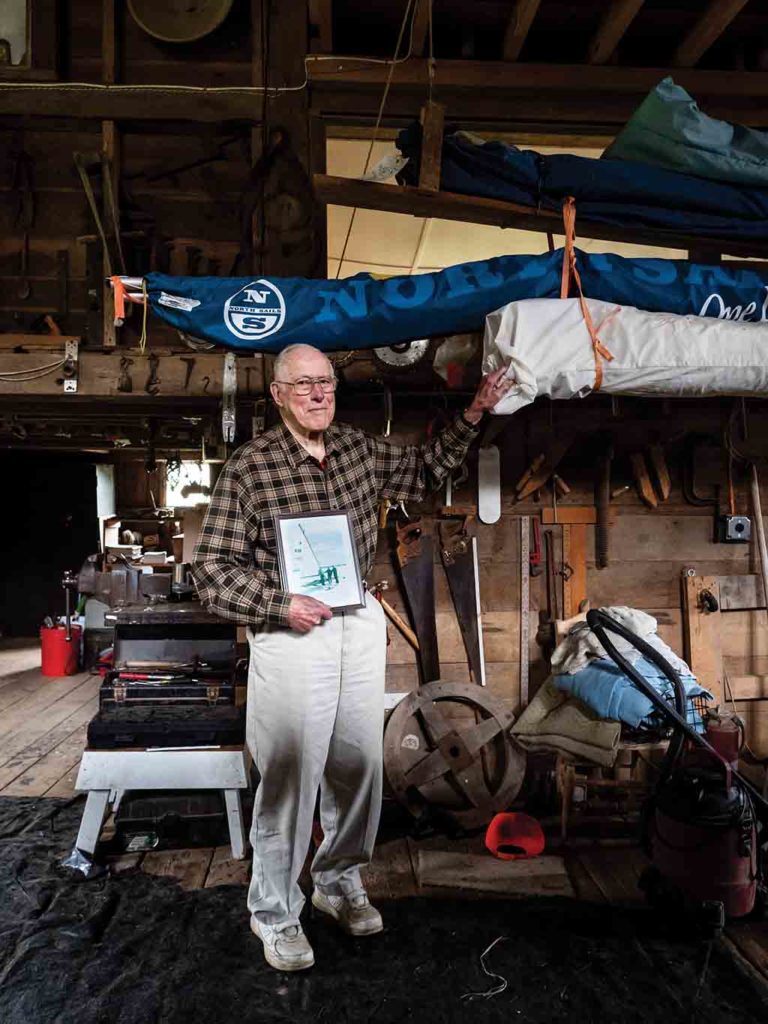
Fred Wardwell, here in his boat barn in Searsmont, first experienced ice boating in the 1920s. 
Bill Buchholz of Camden is president of the Chickawaukie Ice Boat Club and builds and repairs boats for water and for ice.
That’s how we come to meet Fred Wardwell. He brings more than 90 years of ice boat memories to bear when he points at an old photo from a race day or at a boat hull in the rafters of the barn attached to his early-1800s house in Searsmont. He lives here with his wife, Ann Wardwell. She’s the daughter of novelist and short-story writer Ben Ames Williams, who set many of his stories in Maine. The farmhouse, filled with paintings of clipper ships and Maine landscapes, has been her family’s summer home for generations. Over the years, Wardwell has built several ice boats of cedar and spruce in this barn. “I made mine hollow to be lighter—most are solid,” he says. He’s also made various trailers, including a space rocket–shaped tube for transporting a DN.
Born in 1922 in Upstate New York, Fred Wardwell is a retired president of a paper-making company who had piloted twin-engine bombers in World War II. He’s been familiar with ice boats since he was a boy and recalls his mother’s stories of her own ice boat excursions when she was a young woman. Since moving to Maine in the 1980s, Wardwell says, he’s never sailed on the “soft water” of warmer months, only on ice. For about 20 years until recently he’d take to the frozen ponds and lakes around the midcoast regularly every winter.

Wardwell, meanwhile, is slowing down some, and last sailed one of his ice boats two years ago. But if the weather and ice are good, he says, he may get out there again one day this winter. If he does, he’ll be 97 when he takes to the ice and wind.
“We are blessed here with more good ice than most places,” he says. He’s especially enjoyed days on Chickawaukie Lake near Rockland, where members of the Chickawaukie Ice Boat Club would meet on the shore of the home of Lloyd Roberts, a local physician and fellow enthusiast who devised the Cheapskate and Gambit boat designs and has shared the plans online. Members would race all afternoon and then return for a bonfire and baked beans, Wardwell recalls. The group continues to hold potluck gatherings, and Roberts, who joined the club in the 1970s, is president emeritus and club secretary.
Several of the boaters on the ice at Damariscotta Lake mentioned spending just a few hundred dollars for their boats. Costs can be kept especially low by following the Cheapskate plans, and by using found items for some of the construction, including bedrails from a junkyard. “Ice boats have always been economical,” Wardwell says, so he doesn’t understand why ice boating isn’t more popular. “Why people want to go out on a snow machine or a four-wheeler, I just don’t know. When the ice is glassy with a quarter-inch of water on top, the ice boating is absolutely wonderful.”
Optimal conditions are when the ice is smooth and clear of snow—maybe even a little rain or melt on top—and, of course, there’s wind. Bill Buchholz, president of the Chickawaukie Ice Boat Club, writes up notes about conditions to share with members online. On a recent outing up near Jackman, he found a pond’s ice was just right: “Tight to the shore. No hazards, no open water. Solid as a rock.”
The sport can also be challenging. Wardwell says he’s been thrown from the boat a number of times, and he’s tipped the boat over on its side. Safety margins shrink as you speed up, he cautions. “The next thing you worry about is sliding 30 or 40 miles an hour. The last time it happened I was holding the sheet, and it broke the boat.”

The view of an ice boat sailor on Damariscotta Lake. 
Ice boat enthusiasts share designs and know-how about their boats, many of which are homemade, one-of-a-kind models.
He says he’s not a fan of high-speed rides, but some of the boaters reach speeds of 70 mph or higher, and for a dramatic effect they can heel the boat, leaning onto the runners of one side—sort of a wheelie on ice. That group of sailors includes Buchholz, “who’s probably the most skillful on the ice,” says Wardwell. “He can sail along the entire length of Chickawaukie.”
Buchholz builds and repairs boats (for water as well as ice) at his shop on a wooded road in Camden. He writes many of the scouting reports and blog posts on the club’s website—often full of wintry Maine anecdotes and humor. In a recent post about how Buchholz and other members eventually found sail-worthy ice for the first regatta of the season, he wrote: “The rule of thumb when using an ax to check the ice is that if the blunt end goes through, you will, too. Well, the blunt end went through, so I simply swung it more carefully.”
A softwater transition
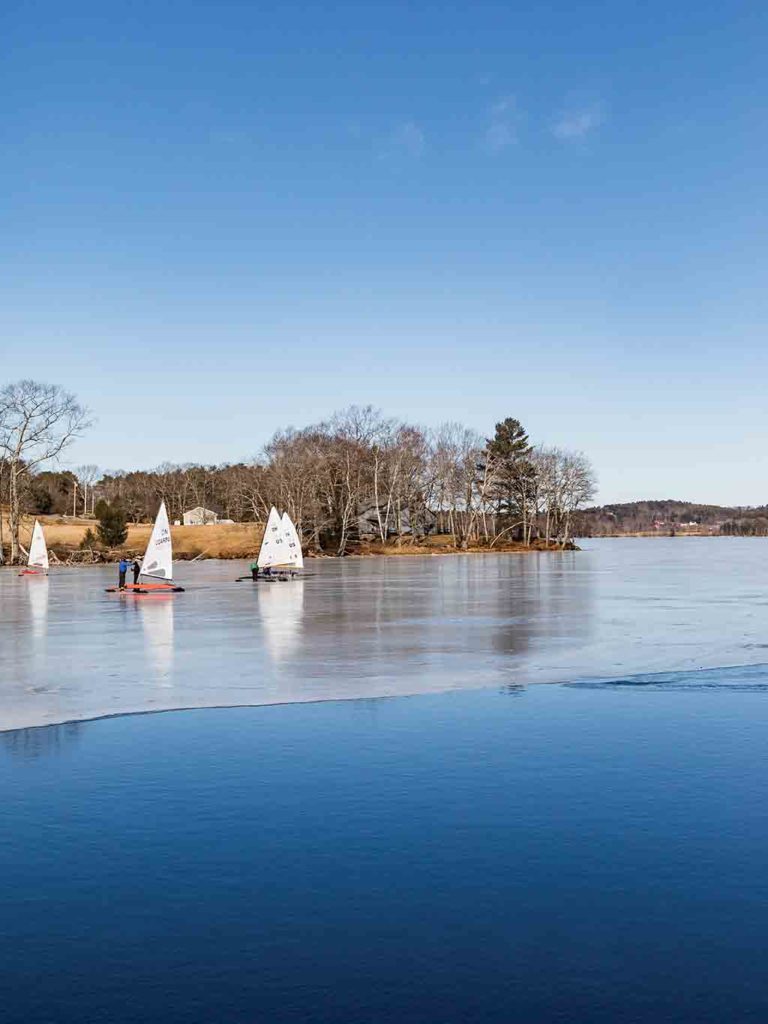
Back on Damariscotta Lake, I watch a curious onlooker take up Wessel’s offer to try out his boat. The man in a red wool coat explains that he sails often in summertime, but never before on a frozen lake. Wessel shows him the basic rigging and lends his helmet, too. Moments after the man sits down, leans back, and pulls the sail taut, the low-profile boat is rocketing across the ice. I watch the boat glide around several others and pass an ice fisherman sitting on a stool. The boats look like butterflies out there, flying across the ice with triangular-shaped wings, and soon I can no longer make out a particular sail among the others in the distance. Ten minutes or so later, the first-timer returns, pointing the bow into the wind to slide to where we’re waiting.
Hopping up from the boat with reddened cheeks and broad smile, he talks excitedly of the experience. “It’s fast! I finally came about into the wind, and I definitely had to use sailing know-how to come to a stop.” I wonder if the longtime softwater boater will want to try sailing again on the solid ice, and soon I have an answer. While walking off toward that widening open water at the lake’s edge, I hear the newbie asking some of the ice-boating veterans, “Know anyone with an ice boat for sale?”
Watch the Ice
The Chickawaukie Ice Boat Club, a volunteer organization of ice-boating enthusiasts founded in the 1960s, scouts locations and posts reports about ice conditions, boats for sale, social gatherings, boat swaps, and races at iceboat.me. A $20 annual membership fee adds you to the mailing list.
Want to see the action? Where the ice boaters will sail next depends on a close watch of frozen lakes and ponds: smooth and clear of snow is what they seek. In recent years, locations have included: Chickawaukie Pond, Knox County Damariscotta Lake, Lincoln County Megunticook Lake, Knox County Messalonskee Lake, Kennebec County Moosehead Lake, Piscataquis County Plymouth Pond, Penobscot County Pushaw Lake, Penobscot County Sebago Lake, Cumberland County Sebec Lake, Piscataquis County.



